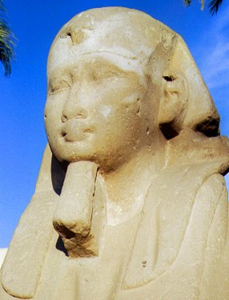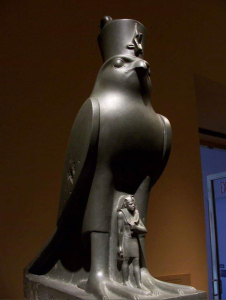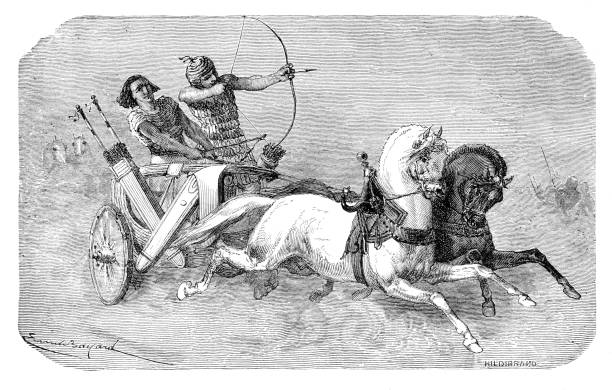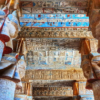The Late Period
The Late Period extended from the 21st to the 30th dynasties (from 1100 to 332 BC).
The Third Intermediate Period
At the end of the 20th dynasty, and during the reign of its last king, Ramses XI, Upper Egypt (Thebes) was no longer under his control. After his death, the Third Intermediate Period began. During the 21st dynasty, they ruled in the Delta, while at the same time, the priests ruled in Thebes. The most famous of them was “Pinedjem”, who placed the royal mummies in a tomb near Hatshepsut’s temple at Al Deir el-Bahri (to protect them from theft). One of the most famous kings of the 21st dynasty was “Psusennes I”, whose tomb was found in Tanis in the Delta. It was no less beautiful than the tomb of “Tut Ankh Amun”, and it was even more magnificent, being entirely inlaid with silver. Silver at that time was more expensive than gold because it was rare in Egypt.
King Psusennes
Silver sarcophagus of King Psusennes I in the Egyptian Museum in Cairo
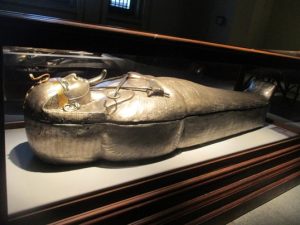
King Psusennes
Golden mask of King Psusennes I in the Egyptian Museum in Cairo
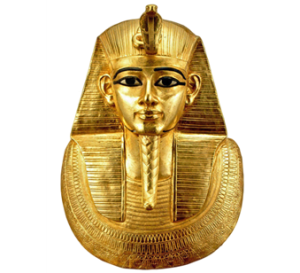
The 22nd to 24th Dynasties
The decentralization of power continued (a ruler governing the north and another governing the south). However, an important king named “Shoshenq I” (945 BC) united the country and founded the 22nd dynasty, which ruled for 230 years from Bubastis in the Delta. He conducted campaigns in Syria and Palestine, and most importantly, he married his daughter to King Solomon and returned with great wealth to the country. However, after his death, the priests controlled the rule of Thebes, and some weak kings controlled the Delta (23rd and 24th dynasties).
The 25th Dynasty
Then came the 25th dynasty, whose kings were of Nubian origin. The most famous of them was King “Taharqa”. At the end of the 8th century BC, the Nubian kings began to advance from Nubia to Thebes. They took over Thebes, then Memphis, and then the Delta, and founded the 25th dynasty.
King Taharqa
He was the most important of the Nubian kings who ruled Egypt. He ruled for about 20 years and was the king who left the most significant monuments in Egypt and Nubia at that time. The most famous of these are his ten columns in the Karnak Temple, of which only one column remains, known as Taharqa’s column in the courtyard of the Karnak Temple. This king carried out many works, but unfortunately, the Assyrians entered Egypt during his reign and expelled him, even from Thebes, which fell under foreign rule for the first and last time. Taharqa fled south to the land of Nubia. The fall of Thebes under the Assyrians was like a major earthquake in the world, similar to the events of September 11, 2001 in America. -A basalt statue head of King Taharqa from the Nubian Museum
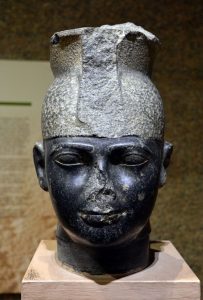
King Taharqa’s column at Karnak
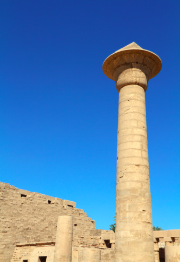
The Karnak Cache
The Assyrians did not respect the Egyptian gods and plundered their temples. Therefore, the Egyptians hated them. In 671 BC, when “Ashurbanipal” invaded Thebes, the priests feared that he would steal the treasures of the Karnak Temple. So, the priests of Karnak gathered all the treasures of Karnak, from small statues of stone or gold to golden vessels, and buried them in a crypt between the temple of Khonsu and the sacred lake. It was discovered by the French scholar Logran from 1903 to 1912 AD and was called the Karnak Cache. It contained priceless treasures, most of which are now on display in the Egyptian Museum in Cairo, some in the Louvre Museum in Paris, some in the British Museum, and others in museums around the world.
Statues of the scribe Amenhotep, son of Habu, discovered in the Karnak Cache from 1903 to 1912 AD
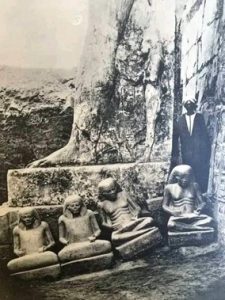
The 26th Dynasty
The Assyrians appointed princes in the Delta, including “Psamtik I”, as governor of the Delta. After their departure from Egypt, he seized control of all of Egypt and founded the 26th dynasty in 664 BC. During his reign, trade flourished, especially with the Mediterranean basin. The country’s treasuries were filled, and temples were built throughout the land. This is called the Late Renaissance in Egypt (the Saite Period).
King Necho II (609-594 BC)
He dug a canal to connect the Nile with the Red Sea. He also built a nilometer in Aswan and made a journey around Africa for three years.
The 27th Dynasty: Persian Rule in Egypt (525-404 BC)
In 525 BC, the Persian king “Cambyses” conquered Egypt and founded the 27th dynasty after killing “Psamtik II”. However, he was not religiously tolerant of the Egyptians and imposed many taxes on them. This led to revolts in Egypt, so his successor “Darius” marched to Egypt to quell the rebellion. He respected the religion of the Egyptians and cared for their temples, so they respected him and the revolts subsided.
The 28th Dynasty
One of the Egyptian princes named “Amyrtaeus” expelled the Persians from Egypt with the help of Greek mercenaries and founded the 28th dynasty. He was the only king of this dynasty.
The 29th Dynasty
It was founded by King “Nepherites I” after he defeated and killed “Amyrtaeus” in Memphis. However, after the death of this king, his sons and grandsons struggled for the throne until King “Nektaneb I” seized the throne in 380 BC, founding the 30th dynasty.
The 30th Dynasty
Founded by King “Nektaneb I”, he continued to rule and spent most of his reign defending Egypt against repeated attempts by the Persians to invade it. The dynasty continued until the reign of King “Nektaneb II”, the last king of Egypt.
King Nektaneb II
was the last king of the 30th dynasty. Among his works was the Avenue of the Sphinxes in front of the Luxor Temple, and he carried out some constructions in the Philae Temple. However, in his reign, in 342 BC, the Persians invaded Egypt again and defeated the king, who fled to Nubia. Their rule continued for 10 years until 332 BC, when Alexander the Great entered Egypt and a new era began. -head of sphinx statue for King Nektaneb I
